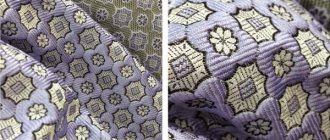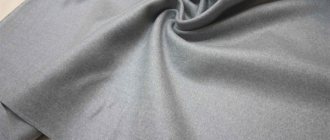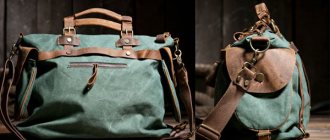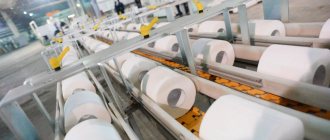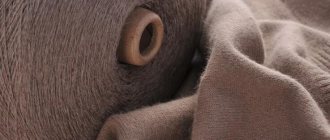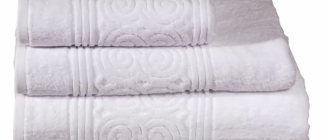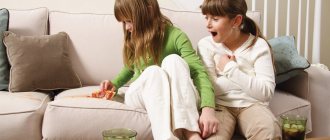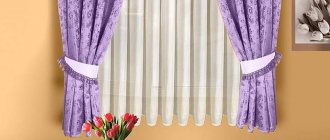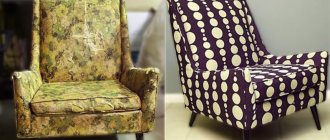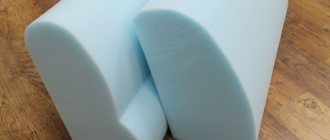Types of furniture fabrics
The main performance properties of materials used as furniture (upholstery) fabric are determined by its composition and manufacturing method. Manufacturers usually classify furniture fabric according to the method of application.
- Primary – upholstery. The fabric used for finishing the external elements of upholstered furniture has high aesthetic characteristics.
- Secondary – cover. Used as a technical coating for various structural elements of furniture: spring blocks, the inside or back of cushion covers, the back and bottom of armchairs and sofas. Budget materials are used as secondary fabric: thick burlap, cotton, chintz, calico, etc.
Durable and easy-to-care upholstery for upholstered furniture in cafes, will make cleaning easier and save money on reupholstery PHOTO: lechim-mebel.kiev.ua
By manufacturing method:
There are several methods for making furniture fabric:
- Woven is a traditional method of production by interlacing threads. For example, jacquard, tapestry, velor, boucle. The pattern on the surface of the upholstery is formed by weaving threads of different colors.
- Non-woven - there are several technologies, the principle of which is to apply various materials (fillers) with a large amount of polymer as a binder to the base. Tissue is formed under the influence of temperature, pressure, dehydration or polymerization reaction.
Furniture upholstery with woven and printed patterns differs significantly both in its aesthetic qualities and durability PHOTO: lineyka.com.ua
The pattern on the surface of the non-woven fabric is formed by printing in two ways.
- Dry – a finished pattern made of thermosetting paint, applied to a technical base (paper or special polymer), is transferred to the fabric under pressure or temperature.
- Wet - the image is applied to the surface through perforations in the walls of special ink drums.
According to the material of manufacture
Raw materials have a key impact on the technical, operational and decorative characteristics of upholstery fabric. Manufacturers usually distinguish between the following materials.
- Natural - environmentally friendly, hygienic, have good breathability and low intensity of exposure as allergens. However, natural materials have mediocre durability, are prone to shrinkage and wrinkle quite a lot. In addition, they are relatively expensive and difficult to care for. The raw materials used are wool, linen or cotton.
- Artificial - obtained by chemical processing of natural materials, for example, cellulose. They have an affordable price, vapor permeability, and a wide selection of colors and textures. They are extremely short-lived and quickly lose their presentation.
- Synthetic - polymer-based materials: nylon, acrylic, nylon, lavsan or polyester. They are characterized by a high degree of wear resistance and resistance to mechanical stress. Synthetic materials are easy to clean, even using household detergents. However, they can accumulate static electricity.
Many modern synthetic upholstery materials can hardly be distinguished from natural ones. On the left is synthetic, on the right is natural suede PHOTO: sambara.com.ua
Important! Artificial and synthetic materials can also cause allergic reactions.
Woven
They are produced by weaving longitudinal and transverse threads, the pile is woven into the base or absent. Pleasant to the touch, textured.
Chenille
Soft, dense and durable material. Pleasant to the body, velvety. It can be either natural or artificial. The natural version has a cotton base.
Characteristics:
- Long lasting.
- Resistant to stretching.
- Does not accumulate dust.
Gozhka
It is made by double or triple weaving of threads, usually from natural fabrics, or mixed with synthetic fibers. Practical and inexpensive material.
Characteristics:
- Durable.
- Good air permeability.
- Doesn't stretch.
However, if there are animals at home, then the matting will not work. Claw marks easily remain on the surface.
Jacquard
Jacquard fabric is interesting due to its special interweaving of threads, which form interesting patterns and relief. Both natural and artificial fiber can be used. This is a beautiful and expensive upholstery material.
Characteristics:
- Abrasion resistance.
- High density.
- Various design options.
Fabric for upholstery - types and main characteristics
There are a huge variety of upholstery fabrics already in use. In addition, manufacturers are constantly developing new materials that combine high resistance to external influences with wide design possibilities: color, texture, pattern, etc.
When communicating with furniture makers, you may encounter the following classification of upholstery fabrics:
- pile (chenille, faux suede);
- non-pile (satin, tapestry, jacquard, boucle);
- non-woven (natural and artificial leather, flock).
Boucle
Relatively new upholstery material. The raw material is polyester thread, from which small loops are drawn along the entire length using special machines. Such fibers are used to make both plain and patterned fabrics, to which knots and irregularities in the structure give visual volume. Bouclé is characterized by high density and strength combined with softness and breathability. This upholstery is a wrinkle-resistant fabric and looks very good on voluminous upholstered furniture.
In boucle design, geometric patterns and stripes are most often used PHOTO: tkac.ru
Chenille
It began to appear en masse in the early nineties. The manufacturing technology is not fundamentally different from weaving lint-free fabrics. But in this case special fleecy threads are used. It was they who gave the name to this material. Chenille means caterpillar in French. Chenille has a wide variety of thicknesses, densities and hairiness, which depend on the raw materials used and the twist of the threads. For example, adding acrylic to the composition will give the upholstery additional softness, elasticity and eliminate wrinkles. Viscose will make the surface velvety and the color will be iridescent. Chenille fabrics are not subject to peeling and can be easily cleaned of dust with a regular vacuum cleaner. More serious stains can be removed using household chemicals intended for textiles.
Chenille has a rich color palette, collections are usually monochromatic PHOTO: kakieshtory.ru
Mat
It is a special variety of chenille. The structure and method of weaving resembles burlap with a slight hairiness on the front surface. Cotton or linen threads with a small amount of acrylic or polyester are used as raw materials for the base. Characterized by high strength and wear resistance. In most cases, the material is hypoallergenic, unpretentious and easy to care for. Used for furniture in Mediterranean, Scandinavian and country style. Recommended for children's interior items.
Matting imitates the rough texture of burlap, can be monochromatic or multi-colored, suitable for upholstering furniture in country style PHOTO: loveshtory.com
Velours
Velor upholstery fabrics are produced using the knitting method. The technology consists in the simultaneous production of two base panels, between which the pile threads are intertwined, secured in a V or W-shape. Then a special machine cuts the weaving threads, which are actually the pile. The second, W-shaped, weave option provides increased pile density and significantly improves the quality and durability of the fabric, but it is more expensive.
Velor combines high aesthetics, affordable cost and relatively high strength characteristics PHOTO: geliopolis.com.ua
Painting of the material is carried out after its production, in rolls. This provides a wide color palette, but slightly reduces fade resistance, and fabrics dyed in rich colors fade. Some brands of velor upholstery can stretch under heavy use. This material is recommended for private household use.
Velveteen
Refers to velor upholstery fabrics. It consists of an interlacing of five threads, one of which forms a pile. The texture is made of longitudinal strips of pile, separated by scars. The quality of the material, as well as its division into types - corduroy and micro-corduroy, is determined by the length of the pile and the width of the hem.
Corduroy is soft and velvety to the touch. It forms an anti-slip surface. It is recommended to use for upholstery of sofas used as a sleeping place. Bed linen will not slide on such a surface. The fabric has high wear resistance and strength.
Furniture corduroy is a completely synthetic or combined fabric with a large percentage of polyester in its composition, characterized by high mechanical resistance PHOTO: zlatamebel.ua
Corduroy upholstery is available only in plain versions, without patterns. However, this is compensated by a wide range of colors and shades. Some manufacturers' coatings, which contain synthetic materials, can accumulate electrostatics. In addition, corduroy is quite difficult to care for and requires special products to clean stains.
Flock
Refers to a type of non-woven textile. The production technology consists of gluing short pile onto a textile base. Modern manufacturers use various materials for the base, front covering and ultra-resistant adhesives. Under the influence of an electrostatic field, the fibers fall strictly vertically onto the adhesive layer. At the next stage, a multi-color pattern is applied to the flock coating using screen printing or embossing. Flock with embossed patterns is usually plain.
Front and back side of flock upholstery PHOTO: elegancetex.com.ua
When caring for flock fabrics, avoid the use of alcohol-based cleaning products, as it can dissolve the glue.
Jacquard
Lint-free fabric with a smooth or textured texture. It retains the original pattern well, which is obtained by weaving fibers of different colors on a special machine. The manufacturing material used is threads made from natural raw materials, cotton or linen in combination with synthetic materials.
Patterned jacquard, the pattern is formed by weaving PHOTO: elegancetex.com.ua
Over time, many improvements to jacquard manufacturing technology have been developed:
- thermal transfer of the pattern to the base is called thermojacquard;
- the use of fleecy threads along with smooth ones gave rise to a new material - jacquard chenille.
The fabric is quite expensive. However, its price is fully compensated by its durability and resistance to mechanical stress and fading.
Plain micro-jacquard with embossing PHOTO: obiv4ik.ru
Tapestry
The upholstery is close to jacquard in terms of manufacturing technology and performance characteristics. It has a clearly defined, albeit less relief, pattern. Made from thicker threads. Typically, more than 10 colors are used. Furniture tapestry is one of the most expensive materials. It is used in premium products.
A traditional pattern for a tapestry is a repeating floral pattern PHOTO: elegancetex.com.ua
Faux suede
Thanks to the use of modern technologies, artificial suede not only completely imitates natural material in tactile sensation and visually, but also significantly surpasses it in performance characteristics. It is characterized by high strength and wear resistance, resisting even significant mechanical stress without any damage to appearance. Resistant to ultraviolet radiation. Has an affordable price.
It has an expensive appearance, but requires careful care PHOTO: poztelio.com
However, it has a number of disadvantages. The main thing is low susceptibility to moisture, which has caused difficulty in cleaning. Grease stains, stains from fruit juices and sweet substances are almost impossible to remove on your own without damaging the surface. Therefore, despite its presentable appearance, artificial suede is not recommended for use as upholstery in areas of intensive use.
Faux leather
The base material is a knitted fabric made of synthetic threads coated with special examples. Many modern manufacturers offer consumers artificial leather that is practically indistinguishable from natural leather. This material is characterized by good durability, resistance to deformation and abrasion. One of the biggest disadvantages of artificial leather is its low resistance to mechanical damage. It is easy to scratch, and from systematic exposure to high temperatures it can crack.
Artificial leather is produced using a variety of technologies, from cheap dermantine to expensive coatings that cannot be distinguished from natural leather PHOTO: obbivka.com.ua
Alcantara
Alcantara was developed in the 70s of the last century. It is a synthetic analogue of suede. The manufacturing material used is polyurethane and polyester substances in the fibers. The production process is quite complex and includes many stages: spinning, impregnation, dressing, perforating, painting and some others.
Thanks to its high performance characteristics, Alcantara is widely used in many industrial areas. It is used to make decor and is used as interior decoration for yachts and car showrooms. Alcantara furniture upholstery is characterized by high durability, resistance to abrasion and mechanical damage. It is vapor permeable and UV resistant.
Alcantara was originally developed for the automotive industry, and is currently used in the production of luxury furniture PHOTO: taxpolice.spb.ru
Genuine Leather
It is one of the best materials for upholstery. Used in premium and elite class furniture. Characterized by high aesthetic and performance indicators. The thickness varies between 0.8-1.9 mm. It has a wide palette of colors, mostly monochromatic. The most expensive and high-quality products may have embossing. High-quality leather coverings are characterized by softness, wear resistance, strength, and the paint on the surface does not crack or crumble.
Genuine leather, used as furniture upholstery, is superior in its technical and aesthetic parameters to most synthetic and natural materials, but requires more careful, specific care PHOTO: legko.com
Leather is a natural material with a capillary-porous structure. Substances (natural or synthetic fats) located inside the pores give the coating the necessary elasticity. During use, they gradually dry out or erode. Therefore, to prevent cracking of the face layer, natural leather is periodically lubricated or sprayed with a special stearic lubricant.
The decorative properties of genuine leather are not limited to painting; embossing and relief formation are no less effective means of artistic finishing PHOTO: belmebru.ru
Useful tips
TYPES OF FURNITURE FABRICS
The need for comfortable conditions is second in importance after the need for food, therefore, since ancient times, people have been striving to make their home as comfortable as possible.
Surrounding ourselves with useful things and paying tribute to functionality, we attach great importance to the interior and textiles, which form the overall tone of the space and create comfort. Psychologists have proven that the interior affects mood and well-being, and therefore life in general. An important part of the interior, of course, is upholstered furniture, because it is it that largely sets the stylistic direction of the room. Having stepped into the age of high technology, humanity has a real opportunity to have comfortable and beautiful furniture. Upholstered furniture, the embrace of which is so pleasant to fall into after a hard day, pleases not only a tired body, but also brings aesthetic pleasure from its contemplation. An important element of any upholstered furniture is its upholstery, which bears the main loads during operation and is its calling card. Modern upholstery materials are different in nature and have many types, each of which has a certain set of specified qualities. In the production of modern furniture, both natural and synthetic fibers are used. A balanced composition of upholstery fabrics improves the performance of furniture. Depending on the composition, fabrics have different properties, and to make the right choice, you need to understand which of the consumer properties of furniture fabric are most important. It is also important to divide furniture fabrics into types depending on the intensity of use: • delicate furniture fabrics used for interior decoration;
• furniture fabrics for everyday use, used to decorate upholstered furniture for the home;
• heavy-duty furniture fabrics used for commercial projects.
The company's assortment includes more than 2,000 products.
For the convenience of customers, the range of products offered is presented in three main price segments: Premium ,
Elegance
and
Standart
. To make the right choice of fabric for furniture design, you need to know the characteristics of the fabric, its properties and types.
Jacquard
– one of the most noble and refined furniture fabrics, highly valued by furniture market professionals for its strength, beautiful appearance, and high wear resistance.
The fabric contains a large percentage of synthetic fiber and is easy to use. The fabric got its name in honor of Joseph Marie Jacquard, who invented a unique machine for making this type of material back in 1801. The operation of the machine was controlled by a software mechanism based on punched tapes and punched cards. The jacquard machine automatically interweaves longitudinal warp threads and transverse weft threads in a pre-programmed order and allows you to create relief patterns of any shape on the fabric. The principle of operation of the jacquard loom has been preserved to this day, but production technology has stepped far forward: instead of punched cards, the machine is now controlled by a computer, which makes it possible to very accurately and quickly translate a design of any complexity into fabric. Jacquard can be multi-colored, using different threads, for example, cotton and silk in any, the most exotic shades. The density of the jacquard is regulated by the thickness of the colored threads used, and the most important thing is that when using the jacquard weaving method, the maximum density of threads per unit area is achieved. A characteristic distinctive feature of jacquards is the presence of a woven pattern on both the front side and the back.
Velours
– it’s beautiful and expensive. “Velour” owes its name to the Latin word “vellosus”, which means “shaggy”, and in French “velor” is translated as “velvet”.
Velor is a heavy pile fabric that differs from velvet in having a shorter pile.
Velor is made by weaving five threads. Four of them form the upper and lower bases, and the fifth, distinct from the others, forms the pile. After weaving, the fabric between the warps is cut to create not one, but two rolls of fabric! The fifth thread, the pile thread, plays the most important role in obtaining beautiful and high-quality fabric. Modern technologies make it possible to combine natural and synthetic fibers in the production of velor, which improves their performance characteristics. Weaving methods are divided into V-shaped (the fleecy thread is intertwined with one warp thread) and W-shaped (the fleecy thread is intertwined with two warp threads - thus achieving increased strength of velor and the density of its pile). The velor pile can be split and looped, and also located vertically throughout the fabric or in some areas smoothed to one side. To make it especially attractive in terms of aesthetics, velor is embossed, combed using a stencil, and laid in the form of various patterns. Velor is characterized by high wear resistance. According to the weaving method, velor is a delicate fabric. However, the development of modern technologies makes it possible to carry out additional processing that increases the wear resistance of fabrics. Chenille
is a beautiful, rich furniture fabric that belongs to the group of jacquard fabrics. The material is made using pile weft yarn, obtained by weaving the fibers between two strong threads that are twisted in a spiral. Externally, the fabric is very similar to a furry caterpillar, which is where the name comes from - translated from French “chenille” means “caterpillar”.
Chenille is developed using a technology called "braided candle" used in the United States since the 18th century. Chenille thread, created by weaving simple and fluffy threads, determines the quality characteristics of this type of fabric. If the ratio of thickness, uniform distribution of pile, twist of chenille thread is technologically correct, then it becomes practically inextensible and is well woven into the overall structure of the fabric. According to the composition of the raw material, chenille can consist of threads of the same nature, for example, polyester (synthetic fiber), or be mixed, for example, polyester with viscose, cotton or acrylic. Currently, this is a fashionable textured fabric, pleasant to the touch, with high wear resistance and a wide range of colors. By combining chenille thread with other threads (boucle, melange), you can get a wide variety of spectacular textured fabrics. Currently, this material for furniture design is the most in demand on the Russian furniture market.
Microfiber
– this is a new generation of textiles, velvety, aesthetic, very durable fabric, resistant to chemical and light exposure, breathable. Microfiber is deservedly called the fabric of the third millennium.
The fabric got its name thanks to the technology of manufacturing ultra-thin fibers, the diameter of which is only 0.06 microns. Microfiber is a real fabric made from either 100% polyester or sometimes 100% cotton. Microfiber can be knitted, woven, or non-woven. Microfiber is also divided into glued and non-glued. Thanks to the latest technologies, microfiber is no longer just a monochromatic material. Microfiber with a pattern applied to the surface using a laser is offered to consumers. The fabric can be printed or imitating wool. Microfiber does not fade, does not pill, and is not susceptible to household pollution, which is ensured by the structure of the fiber. Special tests have confirmed that this material has the ability to evenly distribute static electricity. Microfiber is ideal for upholstered furniture of any style.
Flock
is a lightweight non-woven furniture material, which is an application of small particles of natural or synthetic fiber onto a sticky fabric base. The name of this fabric comes from the English word “flock” - “fluff”, “shred”.
Flock is a non-woven textile. The first mention of fabrics created without the use of a loom dates back to the first century BC. The art of gluing chopped pile (which is called flock) onto a dense textile base using a thin layer of resin was born in China and only spread to Europe in the late Middle Ages. When creating flock, fine nylon or polyamide (possibly a pile of complex chemical composition) pile is used. The pre-woven base moves along the loom, while a thin layer of adhesive is applied to it. Flock comes from a hopper located above the machine. Particles of lint are simply poured evenly onto the base. In this case, a constant electrostatic field is created above the base itself. The electrified particles of the pile fall in this field onto the adhesive base strictly vertically, which ensures the evenness of the pile covering and which then creates a feeling of softness when touching the flock. The design can be applied to flock fabric using wet (immediately after production of the fabric itself, still hot) and dry (dry fabric is dyed) printing. Flock can also be embossed or non-embossed. A new generation of flocks – flock on flock.
Scotchgard
- These are simple twill weave fabrics, in the production of which a special oil-, dust- and water-repellent impregnation is used - Scotchguard - a water-based protector that does not contain solvents. “Scotchguard” translated from English means “Scottish protection”. The use of this protective impregnation makes the fabric more resistant to various types of dirt and moisture. Scotch guards are basically cotton fabrics with a printed pattern. Since natural and environmentally friendly fabrics have recently become a priority, this type of fabric is very popular. The variety of color palettes of plain scotch guards and the variety of patterns, often in the theme of abstraction, make it possible to use these fabrics to suit current trends in furniture fashion. All this together allowed fabrics of this type to quickly adapt to the modern furniture materials market. Currently, this fabric is used to make removable covers and so-called “French” sofas.
How to choose fabric for upholstery
Furniture upholstery requires careful selection based on a combination of aesthetic and operational parameters. There are a number of characteristics, after analyzing which you can choose the optimal material for upholstery of upholstered furniture.
- Strength and wear resistance. These two parameters are interrelated and are responsible for the resistance of the material to external mechanical influences. For furniture used in residential premises, the recommended upholstery category is from 0 to 2. If the coating is subject to heavy use (offices, various commercial and public organizations), it is better to use materials of categories from 3 to 5. Naturally, these recommendations do not apply to premium category coatings 6 and 7, which themselves have fairly high reliability and durability.
- Color stability. The ability of the material to resist ultraviolet exposure (fading), as well as the influence of various chemicals and soapy water used in cleaning.
- Breathability. A key parameter if the furniture is used in damp rooms or a coastal climate.
- Fire resistance. Furniture upholstery used in cafes and restaurants must have a high degree of fire resistance and be self-extinguishing.
- Pillability. A parameter characterizing the obstacle to the formation of pellets during long-term operation.
- Anti-vandalism. The fabric must have a strong, non-deformable base; it is recommended for use in apartments where there are small children or pets.
- Easy to care for. Many modern materials require special care products; without them, they quickly lose their original appearance.
A mistake in choosing furniture upholstery can lead to quite sad consequences PHOTO: mosprima.ru
Oddly enough, design is not included in the list of key parameters. Modern manufacturers provide such a wide selection of colors and textures that even from one type of fabric you can choose upholstery for almost any interior style.
Types of fabric for sofas: description
Read about: Softshell: a new type of sports equipment >
And the most crucial moment when choosing upholstery material for furniture is the fabric itself. It comes in different types. Here are some popular upholstery materials for upholstered furniture:
- Flock;
- Canvas;
- Velours;
- Microvelour;
- Jacquard;
- Artificial suede (for example, London series);
- Tapestry;
- Barakan;
- Rozhka and others.
All these types are divided into nine main categories, which are numbered from 0 to 8, to help you figure out which fabric is best to choose for upholstering a sofa or which one to reupholster. They may vary slightly from one manufacturer to another. One thing is the same - the higher the category number, the higher the quality and durability of the fabric and the higher its price. The most expensive fabric for a sofa is number 8.
0 – this includes the lightest fabrics (cotton, some types of chenille and others); 1 – thin tapestry, suede, flock, chenille and the like; 2 – fabrics of category 1, but denser in quality; 3 – even more compacted materials (thick tapestry, thick suede and others); 4 – even heavier types of the same fabrics; 5 – natural dense fabrics; 6 – arpatek, leatherette, eco-leather; 7 – cheap leather (natural); 8 – expensive genuine leather.
Let's look at each type in more detail to find out their features, positive and negative aspects.
- A sofa covered in microvelor fabric is in great demand in any store. The reasons for this are its increased wear resistance, practicality, and pleasant-to-touch surface. In addition, the price of microvelor is not overpriced; it belongs to the middle price category. It is hypoallergenic, as it does not retain dust, and antistatic, which only adds to its advantages.
- Flock is the most common type of fabric for upholstery of upholstered furniture. It is attractive and durable, easy to care for. This material is very resistant to mechanical stress, which is very important for pet owners.
But when choosing which fabric is more practical for upholstery: flock or microvelor, you need to take into account that flock also has one drawback - it strongly absorbs various odors. So it is better to use it for reupholstering furniture in the living room rather than in the kitchen.
- The ideal option in appearance is genuine leather. The drawing can be absolutely anything. And the quality is the same for any leather sofa, if we are talking about choosing really high-quality leather.
Such furniture looks very solid, noble and rich, it is simple and easy to care for, durable. The only disadvantage of this upholstery is the high price.
- However, you can find a similar option at a lower price if you choose artificial leather or eco-leather, which is popular these days. Externally, a cheaper sofa will practically not differ from an expensive one, but this will be reflected in the quality.
Attention!
Fake leather on upholstered furniture will begin to crack and wear out over time, giving it an unsightly appearance.
- A good upholstery option for natural fabrics is cotton. It is harmless and non-toxic at all, it allows air to pass through well and absorbs moisture. Ideal for furniture in a children's room.
A significant disadvantage of natural cotton is rapid wear. But manufacturers often get rid of this “minus” when they cover cotton sofas with special compounds to increase wear and prevent color loss.
- Jacquard will look very beautiful and elegant. It is quite dense, practically does not wear out and does not lose color, and is durable. An even better option is stretch jacquard.
To all the previous positive characteristics, you can add such a feature as debris and dust not sticking to the surface due to the special substances with which the material is coated.
Not everyone can afford jacquard or stretch jacquard upholstery due to the high price.
For frameless furniture, jacquard furniture tape with all kinds of prints is quite popular: Newspaper, Travel, Patchwork and others.
- A beautiful blend of man-made and natural fibers, a fabric called chenille is very common in upholstery. It gives the sofa a rather aesthetic appearance and allows you to make the interior of the room more comfortable, thanks to the pleasant fleecy surface. Chenille is very durable and easy to care for; dirty surfaces can be easily cleaned with a regular vacuum cleaner and a damp cloth or sponge.
- Silk is unusual for upholstered furniture; this option is extremely rare in stores. But when reupholstering an old sofa in your house or apartment, nothing prevents you from using it.
A silk sofa fits well into the appropriate interior, which most often looks elegant, solid and luxurious. The surface of such furniture is very pleasant to the body, quite durable and safe due to its hypoallergenic and antistatic properties.
- Tapestry has been used for hanging for several centuries. It is not for nothing that tapestry furniture is often found in antique stores and apartments with vintage interiors.
The tapestry is strong and durable, the colors and patterns are varied, and it is wear-resistant. But the surface easily fades when exposed to direct sunlight, so you should not place such a sofa next to a window.
- Arpatek is a fabric that was not originally intended for use in residential areas. Manufacturers recommended using it in the manufacture of car covers, so it is as resistant to abrasion as possible.
Arpatek looks like leather, has remarkable characteristics - it is not subject to mechanical stress, does not lose color when exposed to light, is moisture-resistant and easy to care for.
Decorative pillows stuffed with holofiber, which perfectly retains their shape, are very popular. They look great on the velvety surface of a sofa upholstered in luxury corduroy.
Read about how to make your own bumpers for your baby's crib here.
General rules for upholstery care
Any furniture upholstery is initially designed to withstand repeated cleaning. Periodic cleaning using various cleaning products is the key to long-term use and a neat appearance of upholstered furniture. There are several generally accepted rules for keeping furniture upholstery in proper condition:
- regular vacuuming using a special attachment;
- special attention is paid to cleaning seams, places near buttons or areas hidden during the transformation of the mechanism;
- The stiffness of the brush must be selected depending on the type of material. The lower the category, the softer the bristles should be;
- Moisture-permeable upholstery should not be wetted. If wet cleaning is necessary, they are treated with heavily whipped soap foam;
- When wet cleaning artificial leather, genuine leather or waterproof upholstery, you must carefully study the manufacturer's recommendations. Many materials require special care products.
Special products for the care of natural leather make cleaning furniture much easier PHOTO: wildberries.ru
Criterias of choice
In addition to the main performance characteristics (wear and color fastness, peelability, composition), many other factors are taken into account when choosing fabrics for furniture, including:
- compliance with expected loads;
- color, texture, textile design and its compatibility with other interior items;
- comfort of using the fabric and its safety for human health;
- price;
- reliability of the manufacturer brand.
Visual and tactile inspection are mandatory: high-quality furniture fabric has a uniform color, a dense structure without pilling, and does not leave lint particles in the hands when crumpled.
If you are in doubt about the quality of fabric for furniture, you can order a small fragment for independent or laboratory testing.
Purpose
Depending on the functional purpose, all furniture fabrics are divided into secondary (also known as cover or cover fabrics) and primary (upholstery) fabrics. The first group is represented by inexpensive natural compounds hidden between furniture elements or used to make interior covers. The second category includes all upholstery fabrics (both smooth and fleecy) with high levels of decorativeness and wear resistance.
| Task | Recommended fabric type, possible limitations |
| Closing springs or soft filling, upholstering hidden parts of upholstered furniture | Available secondary (also known as covering) fabrics based on cotton, linen or jute fibers: calico, satin, calico, canvas, burlap |
| External upholstery of sofas and armchairs, upholstered headboards | Any primary upholstery material with high wear resistance (from 20,000 cycles) |
| Removable cover or blanket for the sofa | Velor, flock, chenille, microfiber, fleece, faux fur |
| Covers for frameless furniture | Thin, breathable, elastic fabrics for internal covers (ideally membrane impregnated with waterproof pads), high-quality artificial suede, eco-leather, polyester, oxford for external ones |
| Chair upholstery | Tapestry, jacquard - for chairs in living rooms, eco-leather, synthetics with Teflon impregnation - for kitchen furniture |
Additionally, attention is paid to the type of upholstered element. For example, it is not advisable to cover moving areas with fleecy types, but for soft headboards the fabrics should be pleasant to the touch.
Sofa cover
Upholstery of upholstered furniture
Covers for frameless furniture
Headboard upholstery
Chair upholstery
terms of Use
When choosing fabrics, taking into account the expected operating conditions and the location of the furniture, you should focus on the recommendations collected.
| Task | Operating conditions, requirements | Recommended types |
| Decorating furniture in the living room | Frequent use, direct exposure, high demands on upholstery cleanliness | Velor, jacquard, tapestry, leather if necessary to create a rich interior, universal flock |
| Sofa upholstery for bedrooms | High requirements for environmental cleanliness and breathability | Fabrics based on synthetic and natural fibers, jacquard or chenille |
| Upholstery of children's furniture | Frequent contamination, mechanical stress, jumping | Flock or chenille impregnated with stain-repellent compounds, scotchgard or print for teenagers' rooms |
| Kitchen furniture protection | Contact with oily substances, fire risks, need for private wet cleaning, unpleasant odors | Teflon-impregnated fabrics, eco-leather |
| Upholstery of office or commercial furniture | Highly susceptible to wear and tear, risks of loss of aesthetics after 2–3 years | Flock, artificial leather, synthetic fabrics with abrasion resistance of at least 30,000 cycles (with heavy traffic - from 45,000), chenille or leather - for rooms where smoking |
| Outdoor use (terrace, cafe) | Intense mechanical and atmospheric influences | Dralon, Teflon-impregnated acrylic, specialized fabrics for outdoor furniture |
Indications for reupholstering furniture, stages of work, tips for implementation
Additionally, attention is paid to the proximity of radiators or fireplaces (synthetics do not tolerate them well), the presence or absence of animals in the house (checking anti-vandal properties is mandatory), the likelihood of absorbing unpleasant odors and the expected degree of wear. In apartments with children, where the risk of damage to furniture upholstery increases, the use of fleecy fabrics or those that require only dry cleaning is not advisable.
If you need to wash all types of furniture fabrics frequently, microfiber is the most reasonable solution.
Kitchen
Terrace
Office
Bedroom
Children's
Living room
Room design
The emphasis is on the combination of color, texture and style of fabric, both with other interior items and with the selected model of upholstered furniture. General rules include:
- A ban on the use of richly patterned textiles for upholstery of upholstered furniture with an abundance of stitching or complex cut.
- Combination of fabric pattern with the design of the table or shelves. The simpler the lines of cabinet furniture, the lighter the design should be, and vice versa.
- Consider the brightness and direction of lighting - stamps that wear out quickly or are dark look unsightly in bright light.
When arranging an interior in styles such as classic, baroque or empire, preference is given to leather, corduroy or velor upholstery, jacquard furniture fabrics, and tapestry. Faux suede looks good in loft spaces. Plain flock, chenille, velor furniture fabrics or other brands with a shimmer effect are ideal for lovers of modernism. Fans of innovative ideas should pay attention to fleecy upholstery materials with rich solid colors, jacquard with geometric patterns, imitation watercolor painting on furniture coupons and abstract prints. Microfiber, smooth eco-leather, chenille, flock furniture fabrics, including brightly colored ones, are the optimal solution for modern designs (high-tech, futurism).
Empire style
Country
Classic
Loft
Modern
High tech
Price range
Depending on the cost of the material, fabrics are distinguished:
- Economy class, withstanding no more than 7,000–15,000 abrasion cycles. This group includes budget types of jacquard or tapestry, lightweight brands of chenille, artificial suede, flock or corduroy with a service life of 5 to 7 years.
- Medium class (20,000–35,000 cycles) with a service life of up to 10 years. Standard quality is jacquard, tapestry, dense types of chenille, flock or eco-leather. This group includes furniture coatings with anti-vandal properties and a very interesting design.
- High and premium class (45,000–75,000 or over 100,000 cycles, respectively), imitating natural materials or having a unique design.
When purchasing furniture textiles, you should not go for cheapness: economy-class fabrics pay for themselves only if the upholstery is changed frequently. The material of the middle and high segment, on the contrary, pays off in the long term.
Economy class
Middle class
Premium
Conclusions and recommendations
Based on the many years of experience of many furniture makers, we can give the following recommendations for choosing upholstery material for furniture for various purposes:
- for household use: cotton, flock, scotchgard, thermo-jacquard, corduroy, velor;
- for offices, cafes and other places where furniture is subject to intensive use: jacquard, microfiber, artificial leather, boucle, chenille;
- if the issue of cost is not relevant, for executive and luxury class furniture it is best to use tapestry, Alcantara and genuine leather.
Happy shopping! If you want the author, be sure to fill out the feedback field!
Types of furniture textiles
All the fabrics discussed below are successfully used both for the manufacture of new sofas, armchairs or chairs, and for reupholstering already used ones. When purchasing, you need to remember that the combination of two fabrics of different texture and composition in one product is not welcome, since each has its own characteristics in use and care.
Jacquard
It is considered one of the most sophisticated and elegant upholstery materials. Consists of natural (silk or linen) and synthetic threads.
A special feature of jacquard is the presence of a woven pattern on one or two sides. Due to fibers of different thicknesses and colors, the surface is multicolored, with convex patterns or ornaments.
Jacquard
Making jacquard fabric on special machines is a rather labor-intensive process, so it has a high cost, which means the prices for furniture with such upholstery are quite high. But the cost is more than worth it when you consider the durability and wear resistance for which this fabric is famous. Other advantages of jacquard include:
- strength;
- breathability;
- immunity to ultraviolet rays;
- ease of care.
Interesting fact! Recently, another method of producing jacquard fabric has been developed. Thermal paper with a pattern applied to it is applied to the unpainted canvas, and all this goes to the press. Under pressure, the paint moves deep into the material, securely fastening into the fibers. Textiles produced by this method are called thermojacquard.
Another upholstery fabric, tapestry, is in many ways similar to jacquard. This material is also double-sided, with a clearly defined pattern. But there are also differences: if up to 10 colors are used to produce jacquard, then there are many more of them in a tapestry, and it is made from very thick threads. Therefore, tapestry upholstery or covers are expensive and are used for premium furniture.
Chenille
Translated from French, chenille means “caterpillar”. The fabric received this name because of its special weaving: small fibers are inserted between two fibers, which are then tightly twisted in a spiral. This method, in addition to its special beauty, gives the canvas additional strength.
In terms of composition, chenille can be entirely synthetic, made of polyester, or mixed - with the addition of viscose or cotton. Such materials look very attractive, but have a higher price.
Chenille
Fluffy chenille makes furniture cozy, gives it softness and velvety. You should take note of its properties:
- no peeling;
- resistance to chemicals;
- hypoallergenic;
- practicality;
- variety of designs and colors.
Chenille does not absorb odors, conducts air well and does not require special care. Dust from the upholstery can be easily removed with a vacuum cleaner or soft brush. The fabric will not be damaged if the furniture cover is washed in a machine. Before you begin this operation, you must read the description on the label.
Gozhka
Gozhka
This material, which is one of the varieties of chenille, is reminiscent of burlap or rustic matting in its weave, only with a little hairiness. Most often, the fabric is based on cotton or linen threads, but in order to increase consumer characteristics, a small percentage of synthetics - polyester or acrylic - is added to them.
Furniture decorated with matting is suitable for lovers of country style, as well as Mediterranean and Scandinavian interiors. Due to its naturalness, the fabric is used in children's rooms. The advantages of the material include:
- strength;
- hygroscopicity;
- wear resistance;
- ease of care.
Those who decide to opt for this fabric should remember that matting is afraid of direct sunlight, so it will last longer in rooms with windows facing north.
It is important to know! In a house where there are cats, it is not recommended to install furniture with matting: there is a high probability of the formation of snags that cannot be completely eliminated. Once a cat sharpens its claws several times, the sofa will lose its appearance.
Flock
Flock refers to non-woven textiles. It consists of 30-35% cotton, 65-70% polyester and soft nylon pile, which is applied with glue and gives the fabric fluffiness. As a matter of fact, “flock” is translated from English as “fluff”.
Flock
A characteristic feature of this upholstery is the ability to imitate many materials: velor, chenille, suede and even leather. But, unlike its prototypes, flock is much cheaper, and therefore more accessible and in demand. The advantages of the fabric also include:
- environmentally friendly and hypoallergenic;
- fire safety;
- resistance to damage;
- ease of care;
- significant water resistance;
- pleasant tactile sensations.
A type of material is “flock-on-flock” fabric, in which another row of fibers is applied to the main fabric, giving it additional velvety. This upholstery looks especially attractive, but is not suitable for sofa beds, since it will quickly wear off at the folds due to frequent moving apart.
Important fact! Significant advantages of flock include its anti-vandal qualities. Traces from children's scribbles, spilled coffee or smeared fruit puree can be easily removed with a damp sponge. This material is a godsend for cat owners: the tailed pest in the non-woven fabric has nothing to catch its claws on to sharpen them, and it quickly loses all interest in the sofa or armchair.
Scotchgard
In the production of this natural cotton fabric, special oil-, dust- and moisture-repellent impregnations are used, which give it special properties - resistance to various stains and water. Therefore, upholstery and covers made of Scotch guard (which translates as “Scottish protection”) will serve successfully in kitchens, bathrooms and children's rooms.
The undoubted advantage of the fabric is its environmental friendliness, hypoallergenicity and ease of cleaning. Both plain canvases and those with printed patterns are used. Most often these are various abstractions or floral prints.
Boucle
Boucle
Boucle thread is produced by drawing small loops from regular strong thread using special machines. Polyester is most often used for its production.
Looped fibers are used to make an interesting “voluminous” fabric with a large number of knots, which can be monochromatic or multicolored. The pattern is obtained by weaving multi-colored threads. The most famous is the “chicken foot”.
The original texture of the fabric has remarkable properties:
- amazing softness;
- breathability;
- crease resistance;
- high density.
Like matting, bouclé fabric has a tendency to pull out loops and tighten, so cat lovers should think carefully before choosing it for upgrading furniture or sewing covers.
Velours
An exceptionally beautiful, but at the same time expensive material for furniture. Translated from French, “velor” means “velvet”.
Velours
Velor is often called faux fur for its pleasant and warm pile. This is achieved by combining synthetic, artificial and natural fibers. The fabric can be considered whimsical and capricious, so it is not suitable for a nursery or kitchen. But in an office, living room, billiard room or recreation room, velor for upholstered furniture will come in handy.
The material has the following characteristics:
- safety and non-toxicity;
- strength;
- crease resistance.
Disadvantages include the tendency to become dirty and difficult to maintain. Velor should be cleaned frequently using a vacuum cleaner, and in case of significant stains, using a soap solution. You just don’t need to use chemicals, since the fabric can not only lose the brightness of its colors, but also “go bald.” To make velor upholstery more wear-resistant, it is treated with special water-repellent agents.
Faux suede
This is a fabric imitation of natural material with almost complete visual and tactile similarity. The fabric is soft and velvety to the touch and is highly durable and wear-resistant.
Artificial suede looks expensive and stylish, so it is used in various interiors - from timeless classics to newfangled high-tech. Any room in which there is suede furniture looks chic and status.
In comparison with its natural counterpart, this material only benefits due to the following properties:
- high strength;
- wear resistance and durability;
- resistance to mechanical damage;
- immunity to ultraviolet radiation;
- low cost.
It is important to know! Despite the fact that artificial suede is considered a practical material, it is not recommended to buy furniture with such upholstery for an apartment where there are small children or pets. The thing is that without special products it is almost impossible to get rid of greasy, fruit and other stains, so the best way out of the situation would be removable covers that can be dry cleaned.
Faux suede does not tolerate moisture, which means it only needs to be dry cleaned. To make the upholstery more durable and resistant to stains, Teflon impregnation is used.
Faux leather
This upholstery material can serve as an example of durability and practicality, since, unlike natural leather, it has a low cost. The base is woven or knitted fabric treated with synthetic polymers.
This coating not only makes the material look like its natural counterpart, but also has important properties:
- softness;
- resistance to deformation and abrasion;
- waterproof;
- frost resistance;
- hygiene;
- breathability.
The disadvantages of leatherette include sensitivity to scratches and other damage caused, including by cat claws. Nevertheless, due to the variety of textures, colors and densities, this material is considered one of the most beautiful and representative of all upholstery fabrics.
Microfiber
This new generation of textiles is made from the finest synthetic and artificial fibers and is deservedly considered the fabric of the third millennium.
Upholstery and furniture covers have many advantages, including:
- anti-pilling;
- resistance to pollution;
- lack of ability to generate static electricity;
- ease of care;
- breathability;
- hygiene;
- high strength.
Despite the fact that the material is unnatural, its production technology meets all safety criteria. Furniture with microfiber is suitable even for the smallest children, since it does not cause allergies and does not emit harmful substances.
Any person strives to make his home as beautiful and comfortable as possible. Modern upholstery fabrics for upholstered furniture will help emphasize the style of the interior and fill it with warmth and comfort.
Blog
Advantages and disadvantages of furniture fabrics
The service life of your furniture depends not only on a durable and high-quality frame and a convenient transformation mechanism, but also on the material from which the upholstery is made.
To choose the right upholstery for your furniture, you need to know what properties and advantages different types of furniture fabrics have, and you also need to take into account the disadvantages and possible defects that may arise during the operation of the finished product. Let's look at the main advantages and disadvantages of the most popular furniture fabrics.
Microfiber is a new generation of upholstery material. The velvety and aesthetic fabric is highly durable, has good air permeability to the internal parts of products, and is resistant to chemical and light exposure.
Benefits of microfiber:
- softness (the fabric causes a pleasant tactile sensation, suitable for decorating children's furniture);
- hypoallergenic (high-quality polyester fiber does not cause skin irritation and does not accumulate external allergens: dust, pathogenic microorganisms);
- high absorbency;
- breathability (absorbed moisture evaporates freely, thereby maintaining a comfortable tactile and temperature environment);
- wear resistance (does not wipe off, does not change color, does not fade, does not leave pellets or fluff on the surface);
- easy care (easily cleaned with ordinary detergents, does not require ironing).
Disadvantages of microfiber:
- accumulates static electricity (in some circumstances it can become electrified, but this is not considered a permanent property of the fabric);
- does not tolerate high temperatures (drying on a radiator, washing at high temperatures, ironing microfiber products is not recommended, since the fabric is deformed from excessive heat and loses its former appearance and shape).
Chenille, as we wrote earlier, is also in high demand among furniture manufacturers. This is a dense fabric with jacquard weaving, which contains twisted threads with fibers, giving the finished material a pleasant silkiness.
Benefits of chenille:
- high wear resistance;
- environmental friendliness due to the presence of natural fibers;
- softness due to raised pile;
- no pellets form on the fabric;
- keeps warm;
- does not wear off over time;
- does not wrinkle;
- does not absorb odors;
- creates a cozy atmosphere in the room.
Disadvantages of chenille:
- the material is not waterproof - difficult to remove stains form (stains can only be removed with a special stain remover for upholstery fabrics; aqueous solutions with detergents cannot be used);
- fades from constant sunlight;
- the fabric is damaged by the claws of pets;
- Tights may form from metal parts of clothing.
Velor is beautiful and expensive. Translated from French, “velor” is translated as “velvet”, but this type of material differs from velvet in having a longer pile.
Advantages of velor:
- softness and smoothness;
- hypoallergenic;
- durability;
- easy cleaning from dirt;
- velor does not fade;
- The velor upholstery does not stretch.
Disadvantages of velor:
- forms creases;
- the material is resistant to damage only with special impregnation;
- abrasion resistance is average;
- does not tolerate exposure to cleaning chemicals.
Jacquard is one of the most noble and refined fabrics, highly valued by furniture market professionals for its strength, beautiful appearance and high wear resistance.
Jacquard fabrics have a number of advantages that are difficult to overestimate:
- product strength. The complex weave of threads combined with their twisting creates a durable fabric, so jacquard products are durable and can serve you for decades;
- bright color of the product even after numerous washes. The fabric will retain the freshness of its colors even after numerous washes;
- abrasion resistance;
- ease of care. Due to their strength, jacquard fabrics are easy to care for;
- the beautiful appearance of the product remains for many years, and the aristocratic design will always be relevant.
In the recent past, jacquard fabric had only one drawback - high cost, especially for materials with a natural composition. But today, the use of modern technologies makes it possible to reduce the cost of popular furniture upholstery.
Flock is a lightweight non-woven furniture material that is an application of small particles of natural or synthetic fiber onto a sticky fabric base.
Advantages of flock:
- the material has high strength and wear resistance, is resistant to tearing and stretching, and can withstand large temperature changes;
- flock has unsurpassed water resistance. If you spill liquid on a surface, you will notice how droplets of water, like mercury balls, roll down the material. They can be easily removed with a regular napkin;
- the material is perfectly dyed in any color, and the dyes are resistant to ultraviolet rays and water;
- The flock is soft, velvety, pleasant to the touch. Flock products have a noble and respectable appearance;
- ease of care. Furniture decorated with flock can be vacuumed, brushed and dirt can be wiped off with a sponge dipped in a soapy solution;
- flock is considered a favorite among materials resistant to mechanical stress. Sofas upholstered in flock are suitable for pet owners. The claw marks of tailed pets will be completely invisible.
Flock has several disadvantages:
- non-woven material is highly electrified and attracts dust, which can be cleaned with a vacuum cleaner;
- when interacting with substances containing alcohol, the material disintegrates;
- flock is afraid of high temperatures, so furniture upholstered from this material is not recommended to be installed near radiators;
- bleaches and solvents containing petroleum products can render products unusable.
To choose upholstery material for sofas, you need to pay attention not only to its advantages and disadvantages, but also to reviews from owners of upholstered furniture. It is difficult to select the best upholstery for a sofa, since each person has his own selection criteria, even expert opinions differ on this issue.
